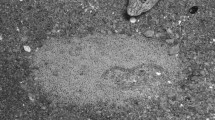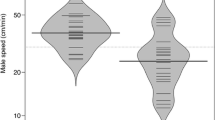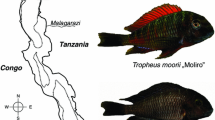Summary
Mating behaviour of the katydid Metaballus sp. varies. At sites QS and DB (in 1982) females competed for access to calling males and males chose mates by mating with heavier, more fecund females. At another site (BR) there was no evidence of role-reversal in reproductive behaviour, and males were observed to compete for mates. This species has a large spermatophore, a product of male reproductive glands, that is eaten by the female after mating. Males at the DB site had small reproductive glands. This suggests that some aspect of the QS and DB environments decreases spermatophore production; spermatophores become a limiting resource for females resulting in the reversal in reproductive roles observed at these sites. A field experiment that involved moving individuals from site BR to QS in 1983 determined that mating system was influerced by site (Table 1). At BR, males produced a continuous calling song, a third of the males observed attracted mates, and called for about 30 min before the female arrived; courtship duration was short. Males that were moved from BR to QS encountered a higher density of receptive females as all males attracted females after an average of just 3 min of calling. They changed their behaviour by producing short periodic bursts of song (“zipping”), and by courting females for long periods of time. The long courtship period may function as as a mate-assessment period for males. The reproductive behaviour of BR males moved to QS differed from that of native QS males only in the length of time spent in copula.
Similar content being viewed by others
References
Altmann J (1974) Observational study of behavior: sampling methods. Behaviour 49:227–267
Bailey WJ, Thiele D (1983) Male spacing behaviour in the Tettigoniidae: an experimental approach. In: Gwynne D, Morris G (eds) Orthopteran mating systems: sexual competition in a diverse group of insects. Westview, Boulder, pp 163–184
Bowen BJ, Codd CG, Gwynne DT (1984) The katydid spermatiphore (Orthoptera: Tettigoniidae): male nutrient investment and its fate in the mated female. aust J Zool 32:23–31
Broughton WB (1963) Method in bioacoustic terminology. In: Busnel R-G (ed) Acoustic behaviour of animals. Elsevier, Amsterdam, pp 3–24
Burk T (1982) Evolutionary significance of predation on sexually signalling males. Fla Entomol 65:90–104
Cade WH (1975) Acoustically orienting parasitoids: fly phonotaxis to cricket song. Science 190:1312–1313
Emlen ST, Oring LW (1977) Ecology, sexual selection and the evolution of mating systems. Science 197:215–223
Feaver M (1983) Pair formation in the katydid Orchelimum nigripes (Orthoptera: Tettigoniidae). In: Gwynne D, Morris G (eds) Orthopteran mating systems: sexual competition in a diverse group of insects. Westview, Boulder, pp 205–239
Gwynne DT (1981) Sexual difference theory: Mormon crickets show role reversal in mate choice. Science 213:779–780
Gwynne DT (1982) Mate selection by female katydids (Orthoptera: Tettigoniidae, Conocephalus nigropleurun). Anim Behav 30:734–738
Gwynne DT (1983) Male nutritional investiment and the evolution of sexual differences in the Tettigoniidae and other Orthoptera. In: Gwynne D, Morris G (eds) Orthopteran mating systems: sexual competition in a diverse group of insects. Westview, Boulder, pp 337–366
Gwynne DT (1984a) Sexual selection and sexual differences in Mormon crickets (Orthoptera: Tettigoniidae, Anabrus simplex). Evolution 38:1011–1022
Gwynne DT (1984b) Courtship feeding increases female reproductve success in bushcrickets. Nature 307:361–363
Gwynne DT, Bowen BJ, Codd CG (1984) The function of the katydid spermatophore and its role in fecundity and insemination (Orthoptera: Tettigoniidae). Aust J Zool 32:15–22
Morris GK (1971) Aggression in male conocephaline grasshoppers (Tettigoniidae). Anim Behav 19:132–137
Morris GK (1980) Calling display and mating behaviour of Copphora rhinoceros Pictet (Orthoptera: Tettigonidae). Anim Behav 28:42–51
Rentz DC (1973) The shield-backed katydids of the genus Idiostatus. Mem Am Entomol Soc 29:1–211
Rentz DCF (in press) A monograph of the Tettigoniidae of Australia. Part I. The Tettigoniinae. Monogr Aust J Zool
Sakaluk S (1984) Male crickets feed females to ensure complete sperm transfer. Science 223:609–610
Thornhill R (in press) Relative parental investment of the sexes to offspring and the operation of sexual selection. In: Nitecki M, Kitchell J (eds) Evolution of behavior. University of Chicago Press, Chicago, III
Trivers RL (1972) Parental investment and sexual selection. In: Campbell B (ed) Sexual selection and the descent of man, 1871–1971. Aldine, Chicago, 136–179
Wade M (1979) Sexual selection and variance in reproductive success. Am Nat 114:742–746
Winer BJ (1971) Statistical principles in experimental design, 2nd edn. McGraw-Hill, Kogakushi Tokyo
Author information
Authors and Affiliations
Rights and permissions
About this article
Cite this article
Gwynne, D.T. Role-reversal in katydids: Habitat influences reproductive behaviour (Orthoptera: Tettigoniidae, Metaballus sp.). Behav Ecol Sociobiol 16, 355–361 (1985). https://doi.org/10.1007/BF00295549
Received:
Accepted:
Issue Date:
DOI: https://doi.org/10.1007/BF00295549




